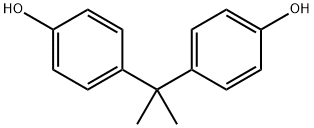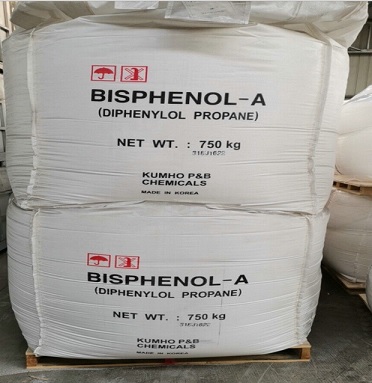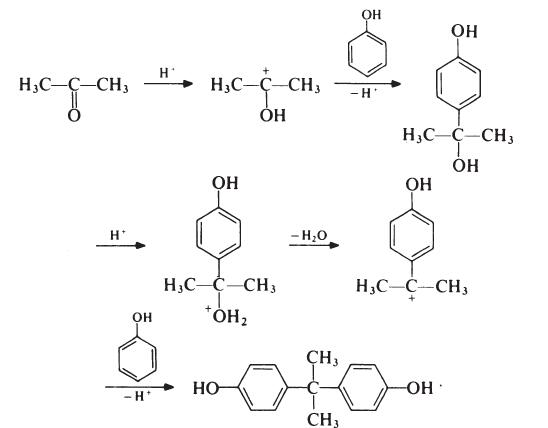
Бисфенол А
- английское имяBisphenol A
- CAS №80-05-7
- CBNumberCB5854419
- ФормулаC15H16O2
- мольный вес228.29
- EINECS201-245-8
- номер MDLMFCD00002366
- файл Mol80-05-7.mol
| Температура плавления | 158-159 °C(lit.) |
| Температура кипения | 220 °C4 mm Hg(lit.) |
| плотность | 1.195 |
| Плотность накопления | 600kg/m3 |
| давление пара | <1 Pa (25 °C) |
| показатель преломления | 1.5542 (estimate) |
| Fp | 227 °C |
| температура хранения | Store below +30°C. |
| растворимость | 0.12g/l insoluble |
| форма | Liquid |
| пка | 10.29±0.10(Predicted) |
| цвет | Clear light yellow to light orange |
| Запах | Phenol like |
| Растворимость в воде | <0.1 g/100 mL at 21.5 ºC |
| Мерк | 14,1297 |
| БРН | 1107700 |
| Диэлектрическая постоянная | 5.0(20℃) |
| ИнЧИКей | IISBACLAFKSPIT-UHFFFAOYSA-N |
| LogP | 3.4 at 21.5℃ |
| Непрямые добавки, используемые в веществах, контактирующих с пищевыми продуктами | BISPHENOL A |
| FDA 21 CFR | 175.105; 175.300; 177.2280 |
| Справочник по базе данных CAS | 80-05-7(CAS DataBase Reference) |
| Рейтинг продуктов питания EWG | 2-5 |
| Словарь онкологических терминов NCI | BPA |
| FDA UNII | MLT3645I99 |
| Предложение 65 Список | Bisphenol A (BPA) |
| Справочник по химии NIST | Phenol, 4,4'-(1-methylethylidene)bis-(80-05-7) |
| Система регистрации веществ EPA | 4,4'-Isopropylidenediphenol (80-05-7) |
| UNSPSC Code | 41116107 |
| NACRES | NA.24 |
| Коды опасности | Xn | |||||||||
| Заявления о рисках | 37-41-43-62-52 | |||||||||
| Заявления о безопасности | 26-36/37/39-45-46-39-36/37-61 | |||||||||
| РИДАДР | UN 3077 9 / PGIII | |||||||||
| WGK Германия | 2 | |||||||||
| RTECS | SL6300000 | |||||||||
| Температура самовоспламенения | 510 °C | |||||||||
| TSCA | Yes | |||||||||
| кода HS | 29072300 | |||||||||
| Банк данных об опасных веществах | 80-05-7(Hazardous Substances Data) | |||||||||
| Токсичность | LC50 (96 hr) in fathead minnow, rainbow trout: 4600, 3000-3500 mg/l (Staples) | |||||||||
| NFPA 704: |
|
рисовальное письмо(GHS)
-
рисовальное письмо(GHS)




-
сигнальный язык
опасность
-
вредная бумага
H335:Может вызывать раздражение верхних дыхательных путей.
H318:При попадании в глаза вызывает необратимые последствия.
H317:При контакте с кожей может вызывать аллергическую реакцию.
H411:Токсично для водных организмов с долгосрочными последствиями.
H360F:Может отрицательно повлиять на способность к деторождению.
-
оператор предупредительных мер
P202:Перед использованием ознакомиться с инструкциями по технике безопасности.
P273:Избегать попадания в окружающую среду.
P280:Использовать перчатки/ средства защиты глаз/ лица.
P302+P352:ПРИ ПОПАДАНИИ НА КОЖУ: Промыть большим количеством воды.
P305+P351+P338:ПРИ ПОПАДАНИИ В ГЛАЗА: Осторожно промыть глаза водой в течение нескольких минут. Снять контактные линзы, если Вы ими пользуетесь и если это легко сделать. Продолжить промывание глаз.
P308+P313:ПРИ подозрении на возможность воздействия обратиться за медицинской помощью.
Бисфенол А химические свойства, назначение, производство
Описание
Reports of bisphenol- A sensitization, particularly in workers at epoxy resin plants, are controversial. Bisphenol-A was also reported as an allergen in fiberglass, semisynthetic waxes, footwear and dental materials.Химические свойства
Bisphenol A is a white or tan crystals or flakes with a mild phenolic odor and a very low vapor pressure (ECB, 2003). It is mildly soluble in water. It is not considered to be an explosive in the conventional sense but can pose a hazard as a finely powdered material in air (ECB, 2003). It is not considered to be a chemical oxidizer.История
Bisphenol A (BPA) was first synthesized in 1891, but it was not used widely until applications in the plastics industry were identified in the 1950s (University of Minnesota, 2008). While the most prominent use of BPA is in the manufacture of polycarbonate plastic and epoxy resins, it is also used in the production and processing of polyvinyl chloride (PVC) and modified polyamide and in the manufacture of carbonless and thermal paper, wood filler, adhesives, printing inks, surface coatings, polyurethane, brake fluid, resin-based dental composites and sealants, flame retardants, paints, and tires (ECB, 2003; EFSA, 2006).
Использование
Bisphenol A (BPA) is used as the constitutional monomer or the monomeric building block of polycarbonate plastics, either by trans-esterification with diphenyl carbonate or via the interfacial process with a monohydroxylic phenol. Together with epichlorohydrin, BPA is also used as a major component of epoxy resins. Bisphenol A-polycarbonate plastics are in turn used in the manufacture of plastic food containers such as reusable water bottles, while epoxy resins are used as inner linings of tin cans. In addition, BPA is also used as an additive in other plastics and polymers, particularly as an antioxidant or stabilizer in polyvinyl chloride, printer ink, and in some other products.Определение
ChEBI: A bisphenol that is 4,4'-methanediyldiphenol in which the methylene hydrogens are replaced by two methyl groups.Подготовка
The formation of bisphenol A is thought to proceed as follows:
Although the reaction theoretically requires the molar ratio of reactants to be 2: 1, an improved yield of bisphenol A is obtained if additional phenol is present; the optimum molar ratio is 4: 1. In a typical process, the phenol and acetone are mixed and warmed to 50??C. Hydrogen chloride (catalyst) is passed into the mixture for about 8 hours, during which period the temperature is kept below 70??C to suppress the formation of isomeric products. Bisphenol A precipitates and is filtered off and washed with toluene to remove unreacted phenol (which is recovered). The product is then recrystallized from aqueous ethanol. Since epoxy resins are oflow molecular weight and because colour is not normally particularly important, the purity of bisphenol A used in resin production is not critical. Material with a p,p'-isomer content of 95-98% is usually satisfactory; the principal impurities in such material are o,p'- and o,o'-isomers.
Общее описание
White to light brown flakes or powder. Has a weak medicine odor. Sinks in water.Реакции воздуха и воды
The finely powdered resin is a significant dust explosion hazard. Insoluble in water.Профиль реактивности
Bisphenol A is incompatible with strong oxidizers. Bisphenol A is also incompatible with strong bases, acid chlorides and acid anhydrides.Опасность
Poison; moderately toxic; teratogen; irritant.Угроза здоровью
Dusts irritating to upper respiratory passages; may cause sneezing.Пожароопасность
Bisphenol A is combustible. Bisphenol A may form explosive dust clouds. Static electricity can cause its dust to explode.Контактные аллергены
Bisphenol A is used with epichlorhydrin for the synthesis of epoxy resins bisphenol-A type, for unsaturated polyester and polycarbonate resins, and epoxy di(meth)acrylates. In epoxy resins, it leads to bisphenol-A diglycidyl ether, which is the monomer of bisphenol-A-based epoxy resins. Reports of bisphenol-A sensitization are rare and concern workers at epoxy resin plants, after contact with fiber glass, semi-synthetic waxes, footwear, and dental materials. It is also a possible sensitizer in vinyl gloves.Возможный контакт
Workers engaged in the manufacture of epoxy, polysulfone, polycarbonate and certain polyester resins. It is also used in flame retardants, rubber chemicals, and as a fungicide. Bisphenol A (BP A), an environmental estrogen, is found in a wide variety of products, including polycarbonate bottles food and drink containers. According to 2008 research conducted at University of Cincinnati, when it comes to BPA, it’s not whether polycarbonate bottles are new or old but the liquid’s temperature that has the greatest impact on how much BPA is released. When exposed to boiling hot water, BPA was released 55 times more rapidly than exposure to cold water.Экологическая судьба
Bisphenol A can be released into the environment during the production, processing, and use of BPA-containing materials, although levels in environmental samples are generally very low or undetectable (ECB, 2003). This is because BPA has low volatility and a short half-life in the atmosphere, is rapidly biodegraded in water, and is not expected to be stable, mobile, or bioavailable from soils (ECB, 2003; Cousins et al., 2002).Most environmental releases of BPA are during the manufacture of BPA-containing products when residual BPA in wastewater is released from treatment plants into receiving streams (Cousins et al., 2002). BPA's half-life in soil and water is in the order of 4.5 days while in air it is <1 day (Cousins et al., 2002). It has a low bioconcentration factor and is rapidly metabolized in fish, with a half-life of <1 day (Cousins et al., 2002).
Перевозки
UN3077 Environmentally hazardous substances, solid, n.o.s., Hazard class: 9; Labels: 9—Miscellaneous hazardous material, Technical Name Required.Методы очистки
Crystallise bisphenol from acetic acid/water (1:1). It is used for making polycarbonate bottles and leaches out slowly on heating. It is a known “estrogenic chemical” shown to disrupt chemical signaling in the complex network of glands, hormones and cell receptors which make up the endocrine system. It causes low sperm count and damages the ecosystem by the feminisation of fish, reptiles and birds. [cf Chapter 1, p 3, Beilstein 6 IV 6717.]Несовместимости
Incompatible with oxidizers (chlorates, nitrates, peroxides, permanganates, perchlorates, chlorine, bromine, fluorine, etc.); contact may cause fires or explosions. Keep away from alkaline materials, strong bases, strong acids, oxoacids, epoxides, acid chlorides and acid anhydrides.Бисфенол А запасные части и сырье
сырьё
1of2
запасной предмет
1of2
Бисфенол А поставщик
| поставщик | телефон | страна | номенклатура продукции | благоприятные условия |
|---|---|---|---|---|
| +8615531157085 | China | 8804 | 58 | |
| +86-29-81148696 +86-15536356810 |
China | 3882 | 58 | |
| +86-13131129325 | China | 5887 | 58 | |
| +86-17331933971 +86-17331933971 |
China | 2472 | 58 | |
| +undefined18602966907 | China | 997 | 58 | |
| +8619931165850 | China | 1000 | 58 | |
| +86-371-86557731 +86-13613820652 |
China | 20259 | 58 | |
| +8615713292910 | China | 341 | 58 | |
| +86-18400010335 +86-18034520335 |
China | 1015 | 58 | |
| +8613343047651 | China | 3692 | 58 |